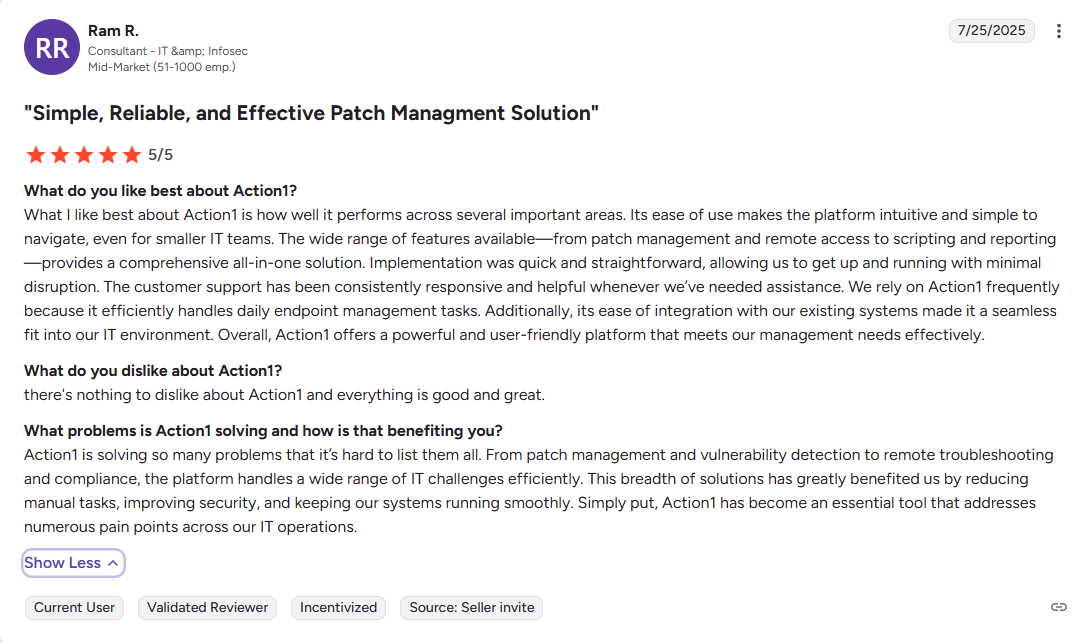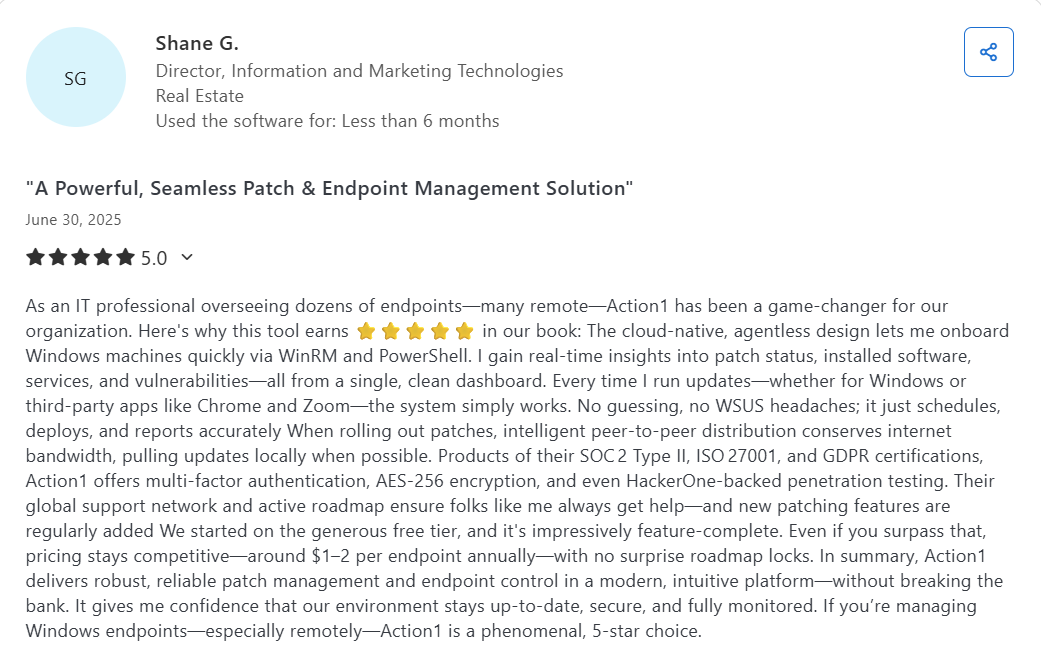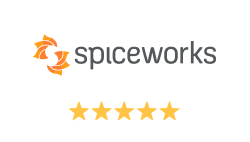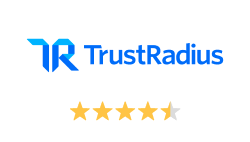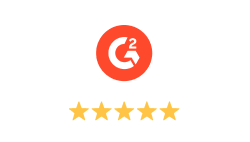TL;DR
Looking for PDQ alternatives? In 2025, top options like Action1, NinjaOne, and ManageEngine offer broader OS support, cloud-native patching, and real-time compliance reporting to replace PDQ Deploy’s Windows-only limitations.
Automated patch management delivers three critical benefits for organizations and their IT teams: it eliminates time-consuming manual processes, protects endpoints from known vulnerability exploitation, and generates comprehensive audit-ready reports for compliance.
In 2025, without patch management software, your business takes too many risks, such as increased risks of falling victim to cybercriminals, facing costly regulatory penalties and fines, data breaches, unexpected downtime, and more.
In other words, such platforms save your organization time and money while enhancing your overall security posture, boosting IT team performance, and ensuring regulatory compliance. Among the available solutions in the market, PDQ Deploy is a great option offering a rich feature set for automating patch management. However, it has some significant limitations, forcing companies of all sizes to look for better alternatives.
In this article, we will explore PDQ Deploy in detail, covering its strengths, key capabilities, and limitations. We will then review the best 9 PDQ alternatives for patch management in 2025, providing a clear overview of what each solution offers and where it may fall short.
Why Consider a PDQ Deploy Alternative?
PDQ is a reliable software deployment tool that helps IT teams to push patches, updates, and custom scripts across their Windows-based endpoints. The software is known for its simplicity, fast setup, and the ability to automate patch and update deployments for on-premise or VPN-connected devices without requiring constant oversight.
This solution is built on two components: PDQ Deploy and PDQ Inventory, keep in mind that they both come under one license. The first component allows you to update Windows operating systems, third-party applications, deploy custom scripts, and handle configuration management changes. The second component is responsible for identifying your endpoints by constantly scanning the network, collecting information, and organizing devices in groups to ensure precise deployment cycles.
However, despite its advantages, the platform has some serious limitations. First, it only supports Windows systems and lacks native support for macOS, Linux, and remote endpoints outside the local network. This creates significant challenges for businesses having hybrid or cross-platform environments.
Second, the software is not cloud-native, meaning that remote deployments are only possible through complex workarounds or VPN setups. Third, reporting on patch validation features is basic, which makes compliance tracking more difficult in regulated industries.
These are the main factors that make business leaders and their IT teams look for better and more advanced cloud-native platforms patch management platforms that equip them with broader OS support and real-time compliance reporting. In 2025, SMBs, MSPs, and large enterprises need flexibility, visibility, and remote patching functions that PDQ Deploy lacks.
What Is the Main Difference Between PDQ Deploy and Action1?
The main difference between PDQ Deploy and Action1 is in the platform architecture, automation, and support they offer to clients. PDQ is an on-premises software deployment and inventory management solution designed for Windows environments that are connected to a local network or use VPN connectivity. This makes it a good choice for on-premises environments, but not for supporting remote endpoints with diverse operating systems, like macOS or Linux (without additional tools), or for managing devices that frequently operate offline without network connectivity.
Action1 is a cloud-native autonomous endpoint management platform that successfully automates patch deployment and software updates across both on-premises and remote devices. It offers automated patching and real-time remediation of security vulnerabilities without needing complex infrastructure, VPN connectivity, or cache servers. Moreover, Action1 equips organizations with efficient management of hybrid environments and offers a centralized dashboard with real time monitoring that delivers the necessary visibility, control, and compliance management across all devices.
This comprehensive solution supports Windows and macOS-based endpoints, and third-party applications, which are of utmost importance for companies that want to protect themselves against cyberattacks launched through vulnerability exploitation.
What’s more, Action1 uses peer-to-peer (P2P) patch distribution, which minimizes external bandwidth usage and speeds up the deployment of large updates. The platform also equips you with the update rings feature, which enables phased, risk-free, and autonomous patch rollouts, advancing updates from inner to outer rings based on success metrics. Reliable patches move forward automatically, while problematic ones don’t, thus effectively reducing downtime risk and ensuring timely vulnerability remediation.
For even greater flexibility and control, you can use the update approval per organization feature, which allows you to independently approve, defer, or decline updates for each unit or department within the Action1 platform. This feature is essential for MSPs, managed clients, and large enterprises.
With built-in remote access, zero infrastructure requirements, and a private software repository, Action1 eliminates the limitations of legacy tools like PDQ. It is infinitely scalable, secure, and ready to configure in minutes. All these features and capabilities make it a way better fit for modern hybrid and remote work environments. Plus, Action1 is free for up to 200 endpoints with no feature restrictions, offering unbeatable value for SMBs and MSPs seeking powerful, autonomous patch management.
How to Choose the Right PDQ Deploy Alternative?
Your choice should be driven by three core factors: platform support for mixed Windows, macOS, and Linux environments; cloud-native architecture to allow you to manage your remote endpoints without VPN hassles; and detailed reporting generation to ease regulatory compliance, which PDQ lacks.
Let’s now break down the steps for choosing the right PDQ deployment alternative:
- Step 1. Look for Cross-Platform Support: A top priority is to find a solution that supports Windows, macOS, and Linux systems.
- Step 2. Third-Party Patching: Pick a solution that offers reliable, automated patching for your business-critical third-party applications.
- Step 3. Prioritize Cloud-Native Architecture: Choose platforms that can patch both your remote and on-premises endpoints through secure cloud connections, eliminating network constraints and reducing IT complexity while supporting offline patching capabilities. If you have employees working from different locations or multiple offices, this is the best option to keep their devices up-to-date, secure, and compliant.
- Step 4. Assess Automation and Compliance Features: Automated patch deployment saves your company time and money by eliminating manually intensive repetitive processes. That’s why you must seek solutions that can successfully automate each step of the patching process: vulnerability identification and risk-based prioritization, missing patch detection, scheduling, testing, and deployment. You also need detailed reporting after each patch or update lifecycle to help you comply with strict regulatory standards.
- Step 5. Consider Scalability and Management: The right PDQ Deploy alternative for your company should allow you to go from hundreds to hundreds of thousands of endpoints seamlessly. Furthermore, centralized dashboards, role-based access controls, and multi-tenant management are essential, especially if you are an MSP or large enterprise. Keep in mind that the best patch management tools offer granular control over update approvals while maintaining autonomous operations and software inventory tracking.
- Step 6. Consider the Total Cost of Ownership: Cloud-native solutions are well-known for reducing TCO, since they don’t require additional hardware or workforce expenses. Indeed, with such a solution, a single administrator can manage thousands of endpoints, thanks to the automation capabilities of these platforms.
Comparison of the Top PDQ Alternative Solutions
The top PDQ alternative solutions are Action1, ManageEngine Patch Manager Plus, NinjaOne Patch Management, Microsoft Intune, Atera, Ivanti Neurons for Patch Management, Lansweeper + Chocolatey, GFI LanGuard, and SolarWinds Patch Manager.
Below, we will compare each of these solutions and discuss their pros, main features, and cons. The goal is to help you make an informed decision and equip your organization with the patch management software that meets your expectations, requirements, and budget.
Action1
Action1 is a cloud-native autonomous endpoint management platform that fully automates the patch management process to keep your organization’s endpoints secure, compliant, and performing smoothly. Once installed (requiring an agent on each managed endpoint), it automatically identifies and prioritizes vulnerabilities across your on-premise and remote endpoints based on CVSS scores, CVE numbers, potential business impact, and active exploitation in the wild.
The platform then catalogs all missing patches and updates across your Windows- and macOS-based devices and third-party applications, allowing you to deploy them immediately or schedule and test them using the update rings feature to prevent unexpected downtime. After each deployment, detailed compliance reports are generated with just a few clicks.
Simply put, Action1 saves you time and money while boosting your organization’s business continuity and reducing the risk of experiencing online attacks launched through vulnerability exploitation.
Pros
- Start patching endpoints in less than 5 minutes and easily scale to as many devices as needed.
- #1 easiest-to-use patch management solution as ranked by independently verified customers on G2.
- Cloud-native architecture with infinite scalability.
- No VPN, appliances, or sophisticated network configuration required.
- The system is certified for SOC 2 Type II, ISO/IEC 27001:2022, and TX-RAMP.
- Works equally well for office-based and remote employee endpoints, servers, and cloud workloads.
- Intuitive user interface.
Cons:
- Linux is now available. Although it was delayed.
Main Features:
- Cross-platform OS support: Windows and macOS.
- Third-party patching: Automated patching for a wide range of third-party applications with real-time progress status.
- Vulnerability management: Real-time identification with built-in remediation.
- Risk-based patch management: Prioritizes and deploys patches based on their CVSS scores, CVE numbers, and potential business impact.
- IT asset inventory: Complete visibility into every endpoint in real-time.
- Software deployment: Streamlined deployment of prepackaged and custom apps.
- Software uninstall: Bulk uninstallation of unauthorized or legacy software.
- Scripting automation: Built-in scripts and custom PowerShell, CMD, or Bash support.
- Real-time reporting: 100+ built-in reports, which you can customize according to your needs.
- Role-based access control (RBAC): Action1’s RBAC is fully customizable with customer-defined roles granting permissions to scopes (organizations, groups, scripts) and functions (reports, automations, dashboards.)
- Single sign-On (SSO) and Multi-factor authentication (MFA).
Unique Features:
- Update rings: Is a remarkable feature designed to make automated patch management more intelligent, staged, and risk-free. With sequential update rollouts, updates move outward in controlled phases, ensuring only reliable patches reach your IT environment while enabling autonomous remediation.
- Update approval per organization: Lets you control software update approvals at the organizational level rather than implementing blanket policies across your entire enterprise. Essential for MSP-managed environments and large enterprises, this feature enables you to autonomously approve, delay, or decline updates for each unit or department within the Action1 platform.
- Ability to patch offline devices: When particular endpoints are offline during scheduled deployments, they automatically receive updates once they reconnect to the network. This capability proves invaluable for remote workers operating across various time zones and locations.
- P2P distribution: Helps minimize external bandwidth usage and ensure rapid deployment of large updates without any on-prem cache servers.
- Privately maintained secure software repository: Provides you with peace of mind knowing that only thoroughly tested patches and updates reach your endpoints.
- Real-time vulnerability data: With CVE numbers, CVSS scores, and exploitation indicators.
- Custom endpoint attributes: Configure custom attributes based on registry keys, installed or missing software, machine type (VM, physical, laptop, server, etc.), warranty expiration date, BitLocker status, free disk space, environment variables, BIOS version, and more.
- Remote access: Allows you to control all endpoints from anywhere directly in the browser, without requiring a VPN.
- Public roadmap: With customer voting for feature prioritization.
- Full REST API access: With OAuth 2.0 at no extra charge.
- Windows feature updates: Upgrade Windows 10 to Windows 11.
- Free for up to 200 Endpoints: Fully featured, with no functional limits, forever for the first 200 endpoints.
G2 rating: 4.9 out of 5.0 (590+ reviews)
Capterra rating: 4.9 out of 5.0 (217+ reviews)
ManageEngine Patch Manager Plus
ManageEngine Patch Manager Plus helps your IT team remediate vulnerabilities in a timely manner by automatically deploying patches across Windows, Linux, and macOS-based endpoints and third-party applications. With the software, you can keep your on-premise and remote devices secured, compliant, and running smoothly from a single console.
Pros:
- Automates end-to-end patch management from detection to remediation.
- Supports patching for Windows, macOS, Linux, and a wide variety of third-party applications.
- Patches systems across LANs, WANs, DMZs, and remote work-from-home systems without a VPN.
- Improves patch reliability through automated testing before deployment.
Cons:
- The initial setup is not as straightforward as expected; users report that they struggle with compatibility issues, especially with older server versions.
- The agent is not customizable enough for specific customer labeling.
- In some cases, patches fail to install without a clear reason. To solve the issues, you must contact their customer support, which can take time, from a couple of hours to several days.
Main Features:
- Cross-platform OS support: Windows/macOS/Linux
- Third-party application patching
- Flexible deployment policies
- Patch compliance management
- Ability to decline patches for legacy applications
- One-click rollback for problematic patches
- Automated patch testing and approval process
- Supports driver patching and BIOS updates (Enterprise Edition)
- Remote shutdown and wake-on-LAN capabilities (Enterprise Edition)
G2 rating: 4.5 out of 5.0 (180+ reviews)
Capterra rating: 4.6 out of 5.0 (330+ reviews)
NinjaOne Patch Management
NinjaOne is a cloud-native platform that streamlines patching processes across your Windows, macOS, and Linux devices. You can also automate updates for many third-party applications with the needed flexibility, control, and visibility. This platform keeps both on-premise and remote endpoints up-to-date, minimizes the attack surface across your network, and eases regulatory compliance through generating audit-ready reports.
Pros:
- Cloud-based patching platform that doesn’t require a VPN connection
- Proactive patching with CVE/CVSS integration
- Works across in-office, remote, and hybrid IT environments
- 14-day free trial period
Cons:
- Devices often get stuck with red or yellow status indicators when updates are pending or failed (doesn’t explicitly indicate which).
- Device groups can’t filter based on relative dates (requires hardcoding specific dates).
- NinjaOne’s subscription-based pricing can be costly for small businesses with few endpoints or nonprofit organizations.
Main Features:
- Cross-platform OS support: Windows/macOS/Linux
- Third-party application patching
- Risk-based patch management
- Patch compliance reporting
- Agent-deployed patching
G2 rating: 4.7 out of 5.0 (2650+ reviews)
Capterra rating: 4.7 out of 5.0 (252+ reviews)
Microsoft Intune
Microsoft Intune is a cloud-based endpoint management platform. It provides your organization with the ability to manage user access to the company’s resources and simplify app and device management across your on-premise and remote endpoints, such as mobile devices, desktop computers, and virtual endpoints. With Intune, you can protect access and data on organization-owned and users’ personal workstations.
Pros:
- Seamless integration with the Microsoft ecosystem
- Supports mobile and BYOD patching
- Scalable cloud architecture
Main Features:
- Mobile Device Management (MDM)
- Application Management
- Compliance Reporting
- Windows update rings and feature update controls
- Expedited patch deployment
- macOS and iOS update policies via MDM
- Conditional access based on compliance
- Integration with Defender vulnerability management
Cons:
- No built-in third-party patching capabilities, except for Windows products.
- Basic per-patch reporting
- Requires higher-tier Microsoft licensing for some features
G2 rating: 4.5 out of 5.0 (210+ reviews)
Capterra rating: 4.5 out of 5.0 (35+ reviews)
Atera
Atera is a cloud-native platform that equips your organization with the ability to automate patch deployments for your on-premise and remote endpoints. It successfully updates Windows, macOS, and Linux-based endpoints, along with numerous third-party applications. Atera automates each phase of the patch management process from vulnerability identification to remediation and reporting.
Pros:
- Integration within broader IT management ecosystem
- Comprehensive reporting suite
- Software bundling for simplified deployment
Main Features:
- Cross-platform OS support – Windows/macOS/Linux
- Third-party application patching
- Patch compliance management
- Software bundles
- Patch Status summary
- Integration with Chocolatey and HomeBrew
- Intuitive interface
Cons:
- Limited Platform Customization
- Disparity in Mobile App Functionality
G2 rating: 4.6 out of 5.0 (835+ reviews)
Capterra rating: 4.5 out of 5.0 (440+ reviews)
Ivanti Neurons for Patch Management
Ivanti Neurons for Patch Management is a cloud-based platform that helps organizations of all sizes remediate software vulnerabilities faster by combining automated patch deployments with real-time risk intelligence. It equips your IT team with shared visibility into which specific vulnerabilities are actively exploited, allowing smarter prioritization. With SLA tracking and phased rollouts, you can protect your on-premise and remote endpoints while aligning remediation efforts with business continuity and compliance goals.
Pros:
- Cloud-native with advanced VRR system
- Active Threat Context for prioritization
- Patch reliability insights from crowdsourced data
Main Features:
- Cross-platform OS support—Windows/macOS/Linux
- Third-party application patching
- Risk-based patch management
- Active threat context
- Patch compliance management
- Advanced VRR system
- SLA tracking for IT and security teams
Cons:
- It can be challenging to align with fixed patch cycles
- There is a learning curve for new users.
G2 rating: 4.0 out of 5.0 (1 review)
Capterra rating:(0 reviews)
Lansweeper + Chocolatey
Pairing Lansweeper and Chocolatey gives your organization an opportunity to manage IT assets and automate software deployments. Lansweeper is a network inventory and asset management solution that allows you to discover, track, and manage your infrastructure with precision.
Chocolatey, on the other hand, is a package manager for Windows-based endpoints that successfully automates the deployment and management of software updates and patches. Simply put, Lansweeper helps you identify the patch status across your endpoints, and Chocolatey is then used to deploy the missing updates across the network.
Pros:
- Low-cost if Lansweeper is already deployed
- Highly flexible scripting-based patching
- Excellent visibility into endpoints’ patch status
Main Features
- OS Support: Windows-based endpoints
- Third-party application patching
- Network-wide hardware/software inventory
- CVE-based risk insights
- Chocolatey scripting for app updates
- Custom deployment packages
Cons:
- No native patch compliance tracking
- Requires manual scripting and maintenance
- Relies on community package reliability
G2 rating: 4.4 out of 5.0 (50+ reviews)
Capterra rating: 4.5 out of 5.0 (70+ reviews)
GFI LanGuard
GFI LanGuard is an on-premises patch management and network security solution that works across Windows, macOS, and Linux endpoints. It enables your IT team to perform in-depth vulnerability scans, automate operating system and third-party application patching, and maintain compliance through detailed reporting. You can also use it to discover devices on your network, spot unauthorized hardware, and generate audit-ready reports to support security and regulatory requirements.
Pros:
- Integrated vulnerability scanning
- Agentless and agent-based options
- Patch rollback support
Main Features:
- Cross-platform OS patching
- Third-party application updates
- Network device vulnerability scanning
- Compliance reporting
- Patch scheduling and automation
Cons:
- Limited third-party app catalog
- No cloud management
- GFI LanGuard can deploy updates to remote endpoints, but with significant limitations compared to truly cloud-native solutions.
G2 rating: 4.2 out of 5.0 (10 reviews)
Capterra rating: 3.8 out of 5.0 (10 reviews)
SolarWinds Patch Manager
SolarWinds Patch Manager integrates with your existing Microsoft WSUS and SCCM systems to automatically deploy Windows OS and third-party application updates, addressing software security vulnerabilities on your devices. The solution also enhances your company’s compliance reporting, helping keep Windows endpoints both up-to-date and secure while meeting the regulatory standards your organization must follow.
Pros:
- Simplifies third-party patching in WSUS/SCCM
- Leverages existing Microsoft infrastructure
- Good reporting options
Main Features:
- OS Support: Windows-based endpoints
- Pre-tested third-party update catalog
- WSUS/SCCM integration
- Advanced patch scheduling
- Patch compliance dashboards
- Orion platform integration
Cons:
- Supports only Windows-based endpoints
- Requires WSUS/SCCM infrastructure
- Not cloud-native
G2 rating: 4.3 out of 5.0 (790+ reviews)
Capterra rating: 4.6 out of 5.0 (570+ reviews)
Comparison Table of PDQ Alternatives
| Tool | Platform Support | Cloud/On-Prem | Patch & Deploy | Best For |
|---|---|---|---|---|
| Action1 | Windows/WoA/macOS/ Linux | Cloud | Yes | Cloud-first, compliance, price |
| ManageEngine | Win/macOS/Linux | Both | Yes | Broad compliance needs |
| NinjaOne | Win/macOS | Cloud | Yes | Full IT visibility |
| Intune | Win/macOS/iOS/Android | Cloud | Yes | Microsoft-centric orgs |
| Atera | Windows | Cloud | Yes | MSPs/IT providers |
| Ivanti | Multi-platform | Cloud | Yes | Security-focused enterprises |
| Lansweeper + Chocolatey | Windows | Hybrid | Yes | Cost-conscious admins |
| GFI LanGuard | Win/macOS/Linux | On-Prem | Yes | Compliance & audits |
| SolarWinds | Windows | Hybrid | Yes | WSUS/SCCM users |
What’s the Best Cloud-First PDQ Alternative Patch Management Tool?
The best cloud-first PDQ alternative is Action1. The platform offers autonomous endpoint management capabilities; it is highly secure, infinitely scalable, easy to use, and enables you to manage your devices from anywhere, without VPN, directly from the browser. With it, organizations of all sizes can keep their on-premise and remote endpoints up-to-date, secure, and compliant with just a few clicks. Action1 automates the entire process from vulnerability identification and remediation to the generation of detailed reports after each update lifecycle.
Which PDQ Alternatives Offer macOS Support?
Action1, NinjaOne, ManageEngine Patch Manager Plus, GFI LanGuard, and Ivanti Neurons for Patch Management offer macOS support. With these solutions, you can automatically and effortlessly patch macOS-based endpoints in a timely manner to strengthen their overall security posture, keep them compliant, and ensure their smooth performance.
What’s the Best PDQ Alternatives for MSPs?
The best PDQ alternatives for MSPs are Action1, NinjaOne, and Atera. They offer remote monitoring, flexibility, advanced features, remote control, and automation capabilities that MSPs need in 2025 to adequately protect their clients’ endpoints. These platforms are an excellent addition to every MSP organization that wants to deliver exceptional services to its clients.
Are There Free Alternatives to PDQ?
Yes, there is a free alternative to PDQ, and this is Action1. The cloud-native autonomous endpoint management platform offers full functionality, forever, for up to 200 endpoints. That’s why Action1 is the perfect choice not only for small and mid-sized businesses that can use it forever, but also for MSPs and large enterprises, since they can test it as long as they want before purchase. Moreover, the platform is infinitely scalable, allowing you to grow from hundreds to hundreds of thousands of endpoints immediately, while benefiting from a gradually lowering per-endpoint cost.
Which PDQ Alternative Offers the Best Compliance Reporting?
Action1 offers the best compliance reporting. The platform provides you with 100+ built-in reports on patching, vulnerabilities, software and hardware inventory, and security configuration. What’s more, you can customize these templates according to your or your clients’ needs for creating audit-ready reports.
Summary and Key takeaways for your best alternative to PDQ Deploy
In 2025, SMBs, MSPs, and large enterprises need patch management solutions that offer automation, reliability, flexibility, scalability, and advanced features to save them time and money and help them strengthen their overall security posture.
Many organizations that currently rely on PDQ Deploy and Inventory to get the job done have spotted the platform’s limitations. The lack of native support for macOS, Linux, and remote endpoints, in addition to the fact that the platform is not cloud-native and has limited report generation, makes business leaders and their IT teams look for better and more advanced patch management platforms. Such solutions can equip them with broader OS support, remote monitoring, real-time compliance reporting, and P2P patch distribution for faster update deployments across their on-premise and remote endpoints.
The best alternatives to PDQ Deploy and Inventory are Action1, ManageEngine Patch Manager Plus, NinjaOne Patch Management, Microsoft Intune, Atera, Ivanti Neurons for Patch Management, Lansweeper + Chocolatey, GFI LanGuard, and SolarWinds Patch Manager.
These advanced security solutions can successfully address all the pain points that PDQ can’t. No matter which of these platforms you choose to use, they will keep your all endpoints secure, up-to-date, and compliant through intelligent automation. So if you are looking for PDQ alternatives, you already have a list of the best options ahead of you.
